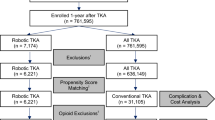Abstract
Introduction
This study elaborates on previous research to compare length of stay, complication rates, and total cost between patients undergoing robotic assisted total knee arthroplasty (rTKA) and conventional total knee arthroplasty (cTKA). We hypothesized that patients undergoing rTKA would have reduced length of stay, lower complication rates, improved perioperative outcomes, and higher total healthcare costs than those undergoing cTKA.
Methods
Data were collected from the National Inpatient Sample Database Healthcare Cost and Utilization Project between the years 2016–2019. Patients undergoing rTKA and cTKA were identified under International Classification of Diseases, 10th revision codes (ICD-10-CM/PCS). Length of stay, specific complications, and total costs were examined at time point. SPSS (v 27.0 8, IBM Corp. Armonk, NY) was utilized to compare demographic and analytical statistics between rTKA and cTKA. rTKA and cTKA were compared both before and after propensity matching.
Results
17,249 rTKA (3.09%) and 541,122 cTKA (96.91%) were included. Compared to cTKA patients, rTKA patients had reduced average length of stay of 1.91 days (p < 0.001), higher average total cost of $67133.34 (p < 0.001), reduced periprosthetic infection (OR = 0.027, p < 0.001), periprosthetic dislocation (OR = 0.117, p < 0.001), periprosthetic mechanical complication (OR = 0.315, p < 0.001), pulmonary embolism (OR = 0.358, p < 0.001), transfusion (OR = 0.366, p < 0.001), pneumonia (OR = 0.468, p = 0.002), deep vein thrombosis (OR = 0.479, p = 0.001), and blood loss anemia (OR = 0.728, p < 0.001). These differences remained statistically significant even after propensity matching.
Conclusions
This study supports our hypothesis that rTKA is associated with fewer complications, but higher average total cost than cTKA. Our study shows that rTKA can be safely performed in older and sicker patients. Future studies assessing the impacts of these findings on patient reported outcomes would provide further insight into the benefits of rTKA. Furthermore, identifying patient specific factors that place them at risk for increased complications with cTKA as opposed to rTKA could provide surgeons insight on the method of TKA that maximizes patient outcomes while minimizing healthcare cost.
Similar content being viewed by others
References
Skou ST, Roos EM, Laursen MB et al (2015) A Randomized, controlled trial of total knee replacement. N Engl J Med 22(17):1597–1606. https://doi.org/10.1056/NEJMoa1505467
Sloan M, Premkumar A, Sheth NP (2018) Projected volume of primary total joint arthroplasty in the U.S., 2014 to 2030. J Bone Joint Surg Am 100(17):1455–1460. https://doi.org/10.2106/JBJS.17.01617. PMID: 30180053
Heo SM, Harris I, Naylor J, Lewin AM (2020) Complications to 6 months following total hip or knee arthroplasty: observations from an Australian clinical outcomes registry. BMC Musculoskelet Disord Sep 10(1):602. https://doi.org/10.1186/s12891-020-03612-8
Song EK, Seon JK, Park SJ, Jung WB, Park HW, Lee GW (2011) Simultaneous bilateral total knee arthroplasty with robotic and conventional techniques: a prospective, randomized study. Knee Surg Sports Traumatol Arthrosc 19(7):1069–1076. https://doi.org/10.1007/s00167-011-1400-9
Song EK, Seon JK, Yim JH, Netravali NA, Bargar WL (2013) Robotic-assisted TKA reduces postoperative alignment outliers and improves gap balance compared to conventional TKA [published correction appears in Clin Orthop Relat res. 2012;470(9):2627]. Clin Orthop Relat Res 471(1):118–126. https://doi.org/10.1007/s11999-012-2407-3
Siebert W, Mai S, Kober R, Heeckt PF (2002) Technique and first clinical results of robot-assisted total knee replacement. Knee 9(3):173–180. https://doi.org/10.1016/s0968-0160(02)00015-7
Kayani B, Konan S, Tahmassebi J, Pietrzak JRT, Haddad FS (2018) Robotic-arm assisted total knee arthroplasty is associated with improved early functional recovery and reduced time to hospital discharge compared with conventional jig-based total knee arthroplasty: a prospective cohort study. Bone Joint J 100–B(7):930–937. https://doi.org/10.1302/0301-620X.100B7.BJJ-2017-1449.R1
Liow MHL, Goh GS, Wong MK, Chin PL, Tay DK, Yeo SJ (2017) Robotic-assisted total knee arthroplasty may lead to improvement in quality-of-life measures: a 2-year follow-up of a prospective randomized trial. Knee Surg Sports Traumatol Arthrosc 25(9):2942–2951. https://doi.org/10.1007/s00167-016-4076-3
Nogalo C, Meena A, Abermann E, Fink C (2023) Complications and downsides of the robotic total knee arthroplasty: a systematic review. Knee Surg Sports Traumatol Arthrosc Mar 31(3):736–750. https://doi.org/10.1007/s00167-022-07031-1
Kayani B, Konan S, Ayuob A, Onochie E, Al-Jabri T, Haddad FS (2019) Robotic technology in total knee arthroplasty: a systematic review. EFORT Open Rev Oct 4(10):611–617. https://doi.org/10.1302/2058-5241.4.190022
Kim YH, Yoon SH, Park JW (2021) Does Robotic-assisted tka result in better outcome scores or long-term survivorship than conventional TKA? A randomized, controlled trial [published correction appears in Clin Orthop Relat Res. ;479(6):1407]. Clin Orthop Relat Res. 2020;478(2):266–275. https://doi.org/10.1097/CORR.0000000000000916
Stauss R, Savov P, Tuecking LR, Windhagen H, Ettinger M (2023) Robotic-assisted TKA reduces surgery duration, length of stay and 90-day complication rate of complex TKA to the level of noncomplex TKA. Arch Orthop Trauma Surg 143(6):3423–3430. https://doi.org/10.1007/s00402-022-04618-8
Archer A, Salem HS, Coppolecchia A, Mont MA (2023) Lengths of Stay and Discharge dispositions after total knee arthroplasty: a comparison of robotic-assisted and manual techniques. J Knee Surg 36(4):404–410. https://doi.org/10.1055/s-0041-1735280
Ofa SA, Ross BJ, Flick TR, Patel AH, Sherman WF (2020) Robotic total knee arthroplasty vs conventional total knee arthroplasty: a nationwide database study. Arthroplast Today 6(4):1001–1008e3 Published 2020 Nov 7. https://doi.org/10.1016/j.artd.2020.09.014
Heinz T, Eidmann A, Anderson P et al (2023) Trends in computer-assisted surgery for total knee arthroplasty in Germany: an analysis based on the operative procedure classification system between 2010 to 2021. J Clin Med 12(2):549 Published 2023 Jan 9. https://doi.org/10.3390/jcm12020549
Yang HY, Seon JK, Shin YJ, Lim HA, Song EK (2017) Robotic total knee arthroplasty with a cruciate-retaining implant: a 10-Year follow-up study. Clin Orthop Surg 9(2):169–176. https://doi.org/10.4055/cios.2017.9.2.169
Hua Y, Salcedo J (2022) Cost-effectiveness analysis of robotic-arm assisted total knee arthroplasty. PLoS ONE 17(11):e0277980 Published 2022 Nov 28. https://doi.org/10.1371/journal.pone.0277980
Rajan PV, Khlopas A, Klika A, Molloy R, Krebs V, Piuzzi NS (2022) The cost-effectiveness of robotic-assisted Versus Manual total knee arthroplasty: a Markov Model-based evaluation. J Am Acad Orthop Surg 30(4):168–176. https://doi.org/10.5435/JAAOS-D-21-00309
Acknowledgements
None.
Funding
None.
Author information
Authors and Affiliations
Corresponding author
Ethics declarations
Ethical approval
None.
Informed consent
None.
Conflict of interest
The authors have no relevant financial or non-financial interests to disclose.
Additional information
Publisher’s Note
Springer Nature remains neutral with regard to jurisdictional claims in published maps and institutional affiliations.
Electronic supplementary material
Below is the link to the electronic supplementary material.
Rights and permissions
Springer Nature or its licensor (e.g. a society or other partner) holds exclusive rights to this article under a publishing agreement with the author(s) or other rightsholder(s); author self-archiving of the accepted manuscript version of this article is solely governed by the terms of such publishing agreement and applicable law.
About this article
Cite this article
Aggarwal, V.A., Sun, J. & Sambandam, S.N. Outcomes following robotic assisted total knee arthroplasty compared to conventional total knee arthroplasty. Arch Orthop Trauma Surg 144, 2223–2227 (2024). https://doi.org/10.1007/s00402-024-05231-7
Received:
Accepted:
Published:
Version of record:
Issue date:
DOI: https://doi.org/10.1007/s00402-024-05231-7




